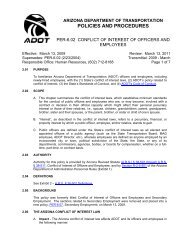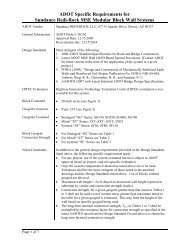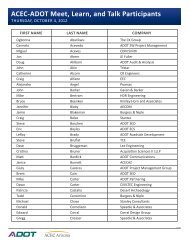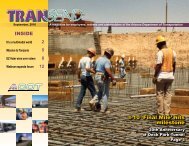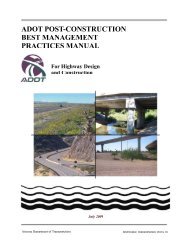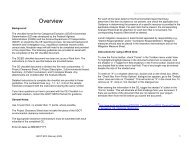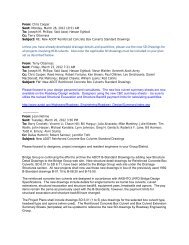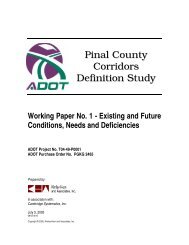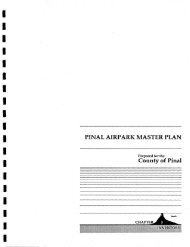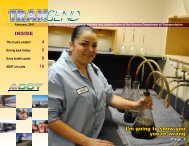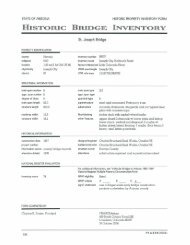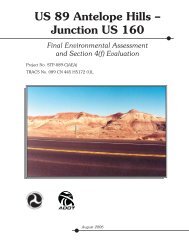I-10 Twin Peaks Traffic Interchange, Environmental Assessment
I-10 Twin Peaks Traffic Interchange, Environmental Assessment
I-10 Twin Peaks Traffic Interchange, Environmental Assessment
You also want an ePaper? Increase the reach of your titles
YUMPU automatically turns print PDFs into web optimized ePapers that Google loves.
Affected Environment and <strong>Environmental</strong> Impacts October 2005<br />
Table 4-6. 2002 Monitoring Data from Coachline Site compared to NAAQS<br />
Site/Location Pollutant (Averaging Period)<br />
Federal<br />
Standard<br />
Monitored<br />
2002 Value<br />
PM2.5 (maximum 24-hour 65 µg/m<br />
concentration)<br />
3 37.0 µg/m 3<br />
Coachline (9597<br />
Coachline Boulevard)<br />
PM2.5 (annual arithmetic mean<br />
concentration)<br />
15 µg/m 3 13.0 µg/m 3<br />
Source: PDEQ<br />
In addition to the requirements discussed above, additional particulate restrictions<br />
apply in the area. SNP, which is within approximately 3 miles of the project area,<br />
is a listed Federal Class I area subject to special particulate matter provisions.<br />
Class I areas, such as national parks, national wilderness areas, and national<br />
monuments are granted special air quality visibility protections under the federal<br />
Clean Air Act; however, these protections apply to stationary sources of pollutants<br />
(i.e. manufacturing and mining) and not to mobile sources of pollutants (motor<br />
vehicles).<br />
CO concentrations within the study area are determined by pollutants emitted into<br />
the airshed (primarily from motor vehicles) and the lack of pollutant dispersion<br />
due to topographical and meteorological characteristics of the Tucson basin. As a<br />
result of these conditions, exceedances of the CO NAAQS were relatively<br />
common in the 1970s; however, no CO violations have been recorded since 1984.<br />
The improvement in CO levels resulted in the Tucson Air Planning Area (TAPA)<br />
being redesignated by EPA to an attainment area for CO in 2000. A limited<br />
maintenance plan was approved that establishes procedures and contingency<br />
measures to be implemented, if necessary, in the future. The plan requires<br />
additional monitoring and modeling of CO concentrations at intersections with the<br />
worst level of service and highest ADT. A limited maintenance plan applies to<br />
areas whose monitored CO concentrations are equal to or less than 85% of the 8hour<br />
CO NAAQS for at least 8 consecutive quarters.<br />
PAG has the responsibility of maintaining the TAPA SIP. In this role, PAG<br />
determines the compliance of local transportation implementation programs and<br />
long range transportation plans with the SIP and conducts the microscale CO<br />
modeling analyses as required by the limited maintenance plan to address those<br />
areas most susceptible to CO violations.<br />
Impacts<br />
No Build Alternative<br />
The no build alternative would not provide an additional access point to I-<strong>10</strong> nor a<br />
grade-separated crossing of the UPRR; therefore, traffic congestion on area<br />
roadways would not be improved and would worsen over time. Increasing traffic<br />
congestion would result in higher emissions from stop and go traffic and idling<br />
vehicles, which would negatively impact air quality. Pedestrian and bicycle facility<br />
Interstate <strong>10</strong> <strong>Traffic</strong> <strong>Interchange</strong> at<br />
<strong>Twin</strong> <strong>Peaks</strong>/Linda Vista<br />
4-47<br />
Project No.: NH-0<strong>10</strong>-D (AIW)<br />
TRACS No.: <strong>10</strong> PM 236 H5838 01D



